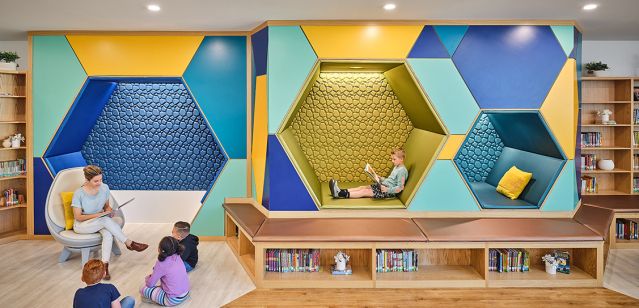Trauma
How School Design Can Help Children Feel Safe
Trauma-sensitive design can create safety and comfort, essential for learning.
Updated September 23, 2023 Reviewed by Devon Frye
Key points
- Children with adverse childhood events may have increased sensitivities and struggle to self-regulate.
- Thoughtfully designed school environments can help children soothe themselves and cope with triggers.
- Trauma-informed design can help all children—not just those who have undergone trauma.
Childhood can be hard even in the best of times. Children are inherently at a power disadvantage, still learning how to manage their emotions, and at the will of adults for food, shelter, and emotional regulation. Frustration, failure, and conflict are unavoidable, but not necessarily bad for children in the long run.
But children today face some uniquely difficult conditions, from school shootings (or the threat of them), to the looming threat of climate change, to the pandemic uprooting their sense of structure, control, and predictability. The accumulation of these overwhelming events, occurring on a regular basis—not to mention the additional very real challenges that many children face at home—could contribute to what some call “small T-trauma” (a term I admittedly don’t love). This can in some cases alter the structure of a child’s brain to be hyper-alert to attempt to control their environment or avoid future pain.
What Do We Mean by Trauma, and How Does it Impact the Brain?
Trauma is often misunderstood as impacting just a small subset of the population, but it actually may be much more common than people realize. Approximately 64 percent of adults in the United States report having experienced at least one adverse childhood experience (ACE) before age 18, and one in six individuals report having four or more ACEs.
It is also not necessarily the event itself that is traumatic, but the way that event is experienced by the mind and body. Physician Gabor Maté often says, “Trauma is not what happens to you, but what happens inside you as a result of what happened to you.” The traumatic stress response is characterized by physiological dysregulation, which can cause a cascade of symptoms that include hypervigilance, increased heart rate, shallow and rapid breathing, warping of time, and severely reduced ability to control fear, emotionality, and perception.
While current definitions of trauma symptoms fall primarily under the heading of post-traumatic stress disorder (PTSD), there is a growing recognition of a related condition, complex PTSD (C-PTSD). Unlike PTSD, which is typically the product of a singular extremely traumatizing event (e.g., a war or a violent attack), C-PTSD is the product of chronic conditions (e.g. ongoing abuse, domestic violence, or neglect), and is often linked to early childhood trauma. Adverse childhood events can underlie these conditions in some cases.
It's important to remember that just because someone experiences an adverse event, it doesn’t necessarily mean they will develop a diagnosable trauma-related disorder; however, it does make it more likely.
Designing Places That Are Trauma-Informed
Humans spend approximately 90 percent of our time indoors—meaning that the built spaces we inhabit have an outsized impact on our lives. The places where we spend our days can offer wonderful ways to soothe us and help people cope with triggers—or they can exacerbate existing struggles and make it even harder for people to feel OK.
Trauma-informed design is a design process intended to help people regulate their bodies and minds to support the processes and practices that take place within the building. It can be applied to therapeutic spaces but also schools, workplaces, homes, and beyond.
Trauma-sensitive design is a step towards normalizing self-regulation as a part of coping with stressful environments. Trauma-informed design can benefit most people, not just those who have been traumatized, since its principles are rooted in evolutionary psychology and the biology of human well-being. Although it will likely be years or decades before we fully understand how the pandemic, climate change, and ongoing school shootings have affected today's children, there are many who believe the need for trauma-informed design will only increase in the coming years.
Here, I'll focus on schools and other places of learning for children, from early childhood to high school. I'll outline six core themes to consider when designing spaces with a trauma-informed approach, based on the trauma-informed principles defined by The Centers for Disease Control (CDC) and Substance Abuse and Mental Health Services Administration (SAMHSA), as well as specific evidence-based design strategies and examples to help any parent, teacher, school administrator, designer, loved one, or community member advocate for schools that support the mental well-being of children. It’s my hope that this article helps explain what trauma-informed design means, why it matters, and how it can be used in schools.

1. Safety
Creating a feeling of safety and comfort is essential for children to learn or, for that matter, for any of us to focus on anything besides our immediate survival. This is especially true for individuals who have experienced trauma and who have difficulty feeling safe or regulating their nervous system. The environment can help support this through numerous means, including the following strategies.
- Sensitive and predictable: Attention to sensory needs and sensitivities (e.g., loud noises, lighting glare) and transitions. This includes adequate lighting on paths of travel, parking lots, bathrooms, etc.
- Calm corner: Provide an area of reduced stimulation where students can go to regulate themselves. Features like a soft area rug, a pillow, and soft lighting can help offer a feeling of safety.
- Biophilia and nature: Opportunities to connect with and view nature and natural elements naturally calm and ground us.
2. Trustworthiness and Transparency
Trust and transparency are important to support the building and maintenance of healthy relationships and experiences at school. The environment can help support this through numerous means, including the following strategies:
- Welcoming: This could include an entryway that offers a degree of transparency or visibility to feel like you know what you are going into and that you're welcome there.
- Wayfinding: The school design supports the ease of finding one’s destination, including signage, color, and symbols that are age-friendly to help you navigate.
- Storage: Ample storage to allow for supplies to be put away in an orderly way helps to reduce visual clutter, which can be overwhelming for someone who is in a chronic state of hypervigilance.
3. Peer Support
Peer support is about opportunities for people going through similar experiences to support each other. Part of any good design is its ability to facilitate the best coping mechanisms humans have: connection with one another. The environment can help support this through numerous means, including the following strategies.
- Adaptable furnishings: Space provides flexible layouts that allow for multiple small or large group arrangements, and customization of the space.
- Shared space: Creating shared outdoor and indoor spaces that are designed for mixing and collaborating on external learning and play activities (e.g., art, sports, reading), can be a great way to overcome barriers and connect.
- Equitable provisions: Avoid creating a hierarchy between parts of the school, which can make certain students—for example, those with limited mobility or who use assisted meal programs—feel othered or excluded.
4. Collaboration and Mutuality
Integrating students, teachers, parents, and administrators is important to help people feel a sense of mutual respect. The environment can help support this through numerous means, including the following strategies:
- Better together: Times when the teachers or administrators can come out from behind a desk, office wall, or podium, and instead join the students in reading circles, playful activities, and vulnerable moments, to support an understanding that we’re all in this together.
- Accessibility: Does the space support ease of mobility for all occupants including those with mobility impairments and other disabling conditions (e.g., compliance with the Americans with Disabilities Act and beyond)?
- Human scale: Creating thresholds, niches, and spaces that help children big and small to feel safe and comfortable in their space.

5. Empowerment, Voice, Choice
This is about how an individual’s strengths and experiences are recognized and built upon. Creating small opportunities to control one’s environment and demonstrate mastery is helpful. The environment can help support this through numerous means, including the following strategies:
- Flexibility: The ability to customize the lighting, where one sits, or how loud a space is allows us to feel a measure of control that helps all of us regulate and feel calm.
- Play and movement: Does your school have outdoor and indoor spaces for movement, play, and exploration (e.g., gym, climbing, swings) to allow students to move throughout their days?
- Choice and options: Do you feel like engaging with others, or not? Do you need to get out of your own head, or do you need to have a space that's your own? This is why environmental choice is so important.
6. Cultural, Gender, and Historical Context
Policies, protocols, and processes should be responsive to the racial, ethnic, and cultural needs of individuals served by the organization. Look for ways to represent student artwork, for example, or create cultural recognition of different student backgrounds in murals around the school. The environment can help support this through numerous means, including the following strategies.
- Identity anchors: People should see themselves literally or metaphorically in a space; this helps to combat isolation and enhance a sense of belonging.
- Inclusion: Does the space have representation or cultural artifacts from the nondominant culture to signal safety and belonging to members of those cultures in the space?
- Gender affirming: Is the space sensitive to all genders, including people who do not identify with a specific gender? Nongendered bathrooms are one of the most effective ways to do this, but it's also important to consider other ways to reduce stigma and increase safety for those who are trans, nonbinary, or genderfluid.
As we move forward in applying trauma-informed design approaches to schools, we can help by learning more, leaning in, and being open to seeing the world differently. Most people do not want to see themselves as victims; rather, trauma-informed design is about seeing us all as humans in need of mutual understanding, belonging, and safety.
References
Note: For more detailed information, refer to the full Trauma Informed Design Evaluation Tool for K-12 Schools.
National Center on Safe Supportive Learning Environments. Home | National Center on Safe Supportive Learning Environments (NCSSLE). (n.d.). https://safesupportivelearning.ed.gov/; Building Trauma-Sensitive Schools Handout Packet (Pilot), https://safesupportivelearning.ed.gov/sites/default/files/Building%20TSS%20Handout%20Packet_ALL.pdf
Trauma Informed Design Society. (2022). Trauma-informed design evaluation tool for K-12 schools. Retrieved from: https://traumainformeddesign.org/wp-content/uploads/2022/09/TiDEvalK12-Tool.pdf on August 01, 2023




